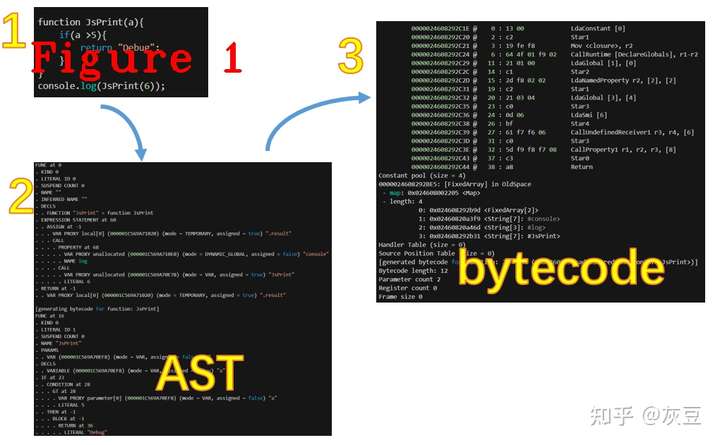

连载《Chrome V8 原理讲解》第六篇 bytecode字节码生成
source link: https://zhuanlan.zhihu.com/p/427676313
Go to the source link to view the article. You can view the picture content, updated content and better typesetting reading experience. If the link is broken, please click the button below to view the snapshot at that time.
连载《Chrome V8 原理讲解》第六篇 bytecode字节码生成
本次是第六篇,讲解V8中抽象语法树(abstract syntax code,AST)到字节码(bytecode)的翻译过程。AST是源代码的抽象语法结构的树状表示,是语法分析的输出结果,bytecode是一种体系结构无关的、在V8中可以运行的抽象机器码,不依赖指令集。本文中,我们以AST作为V8输入,从AST生成后开始调试(Debug),讲解bytecode生成过程,分析核心源码和重要数据结构,如图1所示。本文内容的组织方式:介绍字节码,讲解字节码原理,如何看懂字节码(章节2);AST到bytecode的翻译过程、源码分析(章节3)。

2.字节码介绍
字节码是机器码的抽象表示,采用和物理CPU相同的计算模型进行设计。字节码是最小功能完备集,JavaScript源码的任何功能都可以等价转换成字节码的组合。V8有数以百计的字节码,例如Add和Sub等简单操作,还有LdaNamedProperty等属性加载操作。每个字节码都可以指定寄存器作为其操作数,生成字节码的过程中使用寄存器 r0,r1,r2,… 和累加寄存器(accumulator register)。累加器是和其它寄存器一样的常规寄存器,但不同的是累加器的操作没有显式给出指令,具体来说,Add r1将寄存器r1中的值和累加器中的值进行加法运算,在这个过程不需要显示指出累加器。字节码的定义在v8/src/interpreter/bytecodes.h中,下面展示一部分相关源码。
#define BYTECODE_LIST_WITH_UNIQUE_HANDLERS(V) \
/* Extended width operands */ \
V(Wide, ImplicitRegisterUse::kNone) \
V(ExtraWide, ImplicitRegisterUse::kNone) \
\
/* Debug Breakpoints - one for each possible size of unscaled bytecodes */ \
/* and one for each operand widening prefix bytecode */ \
V(DebugBreakWide, ImplicitRegisterUse::kReadWriteAccumulator) \
V(DebugBreakExtraWide, ImplicitRegisterUse::kReadWriteAccumulator) \
V(DebugBreak0, ImplicitRegisterUse::kReadWriteAccumulator) \
V(DebugBreak1, ImplicitRegisterUse::kReadWriteAccumulator, \
OperandType::kReg) \
V(DebugBreak2, ImplicitRegisterUse::kReadWriteAccumulator, \
OperandType::kReg, OperandType::kReg) \
V(DebugBreak3, ImplicitRegisterUse::kReadWriteAccumulator, \
OperandType::kReg, OperandType::kReg, OperandType::kReg) \
V(DebugBreak4, ImplicitRegisterUse::kReadWriteAccumulator, \
OperandType::kReg, OperandType::kReg, OperandType::kReg, \
OperandType::kReg) \
V(DebugBreak5, ImplicitRegisterUse::kReadWriteAccumulator, \
OperandType::kRuntimeId, OperandType::kReg, OperandType::kReg) \
V(DebugBreak6, ImplicitRegisterUse::kReadWriteAccumulator, \
OperandType::kRuntimeId, OperandType::kReg, OperandType::kReg, \
OperandType::kReg) \
\
/* Side-effect-free bytecodes -- carefully ordered for efficient checks */ \
/* - [Loading the accumulator] */ \
V(Ldar, ImplicitRegisterUse::kWriteAccumulator, OperandType::kReg) \
V(LdaZero, ImplicitRegisterUse::kWriteAccumulator) \
V(LdaSmi, ImplicitRegisterUse::kWriteAccumulator, OperandType::kImm) \
V(LdaUndefined, ImplicitRegisterUse::kWriteAccumulator) \
V(LdaNull, ImplicitRegisterUse::kWriteAccumulator) \
V(LdaTheHole, ImplicitRegisterUse::kWriteAccumulator) \
V(LdaTrue, ImplicitRegisterUse::kWriteAccumulator) \
V(LdaFalse, ImplicitRegisterUse::kWriteAccumulator) \
V(LdaConstant, ImplicitRegisterUse::kWriteAccumulator, OperandType::kIdx) \
V(LdaContextSlot, ImplicitRegisterUse::kWriteAccumulator, OperandType::kReg, \
OperandType::kIdx, OperandType::kUImm) \
V(LdaImmutableContextSlot, ImplicitRegisterUse::kWriteAccumulator, \
OperandType::kReg, OperandType::kIdx, OperandType::kUImm) \
V(LdaCurrentContextSlot, ImplicitRegisterUse::kWriteAccumulator, \
OperandType::kIdx) \
V(LdaImmutableCurrentContextSlot, ImplicitRegisterUse::kWriteAccumulator, \
OperandType::kIdx) \
/* - [Register Loads ] */ \
V(Star, ImplicitRegisterUse::kReadAccumulator, OperandType::kRegOut) \
V(Mov, ImplicitRegisterUse::kNone, OperandType::kReg, OperandType::kRegOut) \
V(PushContext, ImplicitRegisterUse::kReadAccumulator, OperandType::kRegOut) \
V(PopContext, ImplicitRegisterUse::kNone, OperandType::kReg) \
/* - [Test Operations ] */ \
V(TestReferenceEqual, ImplicitRegisterUse::kReadWriteAccumulator, \
OperandType::kReg) \
V(TestUndetectable, ImplicitRegisterUse::kReadWriteAccumulator) \
V(TestNull, ImplicitRegisterUse::kReadWriteAccumulator) \
V(TestUndefined, ImplicitRegisterUse::kReadWriteAccumulator) \
V(TestTypeOf, ImplicitRegisterUse::kReadWriteAccumulator, \
OperandType::kFlag8) \
//.........省略很多.....上面这段代码是字节码的宏定义,用语句V(Ldar, ImplicitRegisterUse::kWriteAccumulator, OperandType::kReg)举例说明,Ldar是加载数据到累加器,ImplicitRegisterUse::kWriteAccumulator, OperandType::kReg说明了Ldar指令的源操作数和目的操作数,具体讲两条字节码的含义,如下:
(1) LdaSmi [1],这里的[1]是Smi小整型(small int)常量,加载到累加器中,如图2所示。
(2) Star r1,这里的r1是r1寄存器,把累加器中的值写入到r1寄存器,目前累加器的值为1,执行完后r1的值为1,如图3所示。
其它字节码指令参见V8的指令定义文件,这里不再赘述。V8为了提升性能,会把多次执行的字节码标记为热点代码,使用优化编译器(TurboFan)把热点代码翻译成机器相关的本地指令,达到提高运行效率的目的,如图4所示。
解释器将AST翻译成字节码比TurboFan用时更短,对于运行次数较少的代码非常合适,即不在运行次数较少的代码上付出更高的编译代价。TurboFan则是对常用代码(热点代码)进行本地化编译,生成体系结构相关的机器码,这需要更长的编译时间,换来的是更快的执行速度。
去优化,是将机器码转成字节码,为什么要这样做?原因有很多,详细原因参见TurboFan的定义文件。这里说一个与技术开发人员相关的原因:调试javascript源码,对源码进行调试时,需要转回字节码。
3.字节码生成
聊字节码生成之前,先要看明白AST树的结构,明白了AST树结构,也就知道了字节码生成其实是遍历树的过程,落地到程序上就是一个有限状态自动机,具体实现就是switch case配合一些预设的宏定义模板,图5给出了AST的数据结构。
AST树的每个节点都继承自AstNode这个类,可以说一切皆“AstNode”。AstNode的成员方法是最多的,在众多方法中,AstNode的NodeType方法无疑是最重要的,因为把一个AstNode节点翻译成字节码时,首先,根据NodeType把父类AstNode转成具体的子类,比如,转成表达式(ExPRESSION)或语句(STATEMENT);其次,才能读取相应的数据、生成字节码,下面的代码是AstNode转成Assignment的具体实现。
void BytecodeGenerator::VisitAssignment(Assignment* expr) {
AssignmentLhsData lhs_data = PrepareAssignmentLhs(expr->target());
VisitForAccumulatorValue(expr->value());
builder()->SetExpressionPosition(expr);
BuildAssignment(lhs_data, expr->op(), expr->lookup_hoisting_mode());
}在这段代码中,计算expr->target(),expr->value(),expr->op()时可能会发生递归调用,因为表达式内可以包含多个子表达式。
void BytecodeGenerator::GenerateBytecodeBody() {
// Build the arguments object if it is used.
VisitArgumentsObject(closure_scope()->arguments());
// Build rest arguments array if it is used.
Variable* rest_parameter = closure_scope()->rest_parameter();
VisitRestArgumentsArray(rest_parameter);
// Build assignment to the function name or {.this_function}
// variables if used.
VisitThisFunctionVariable(closure_scope()->function_var());
VisitThisFunctionVariable(closure_scope()->this_function_var());
// Build assignment to {new.target} variable if it is used.
VisitNewTargetVariable(closure_scope()->new_target_var());
// Create a generator object if necessary and initialize the
// {.generator_object} variable.
FunctionLiteral* literal = info()->literal();
if (IsResumableFunction(literal->kind())) {
BuildGeneratorObjectVariableInitialization();
}
// Emit tracing call if requested to do so.
if (FLAG_trace) builder()->CallRuntime(Runtime::kTraceEnter);
// Emit type profile call.
if (info()->flags().collect_type_profile()) {
feedback_spec()->AddTypeProfileSlot();
int num_parameters = closure_scope()->num_parameters();
for (int i = 0; i < num_parameters; i++) {
Register parameter(builder()->Parameter(i));
builder()->LoadAccumulatorWithRegister(parameter).CollectTypeProfile(
closure_scope()->parameter(i)->initializer_position());
}
}
// Increment the function-scope block coverage counter.
BuildIncrementBlockCoverageCounterIfEnabled(literal, SourceRangeKind::kBody);
// Visit declarations within the function scope.
if (closure_scope()->is_script_scope()) {
VisitGlobalDeclarations(closure_scope()->declarations());
} else if (closure_scope()->is_module_scope()) {
VisitModuleDeclarations(closure_scope()->declarations());
} else {
VisitDeclarations(closure_scope()->declarations());
}
// Emit initializing assignments for module namespace imports (if any).
VisitModuleNamespaceImports();
// The derived constructor case is handled in VisitCallSuper.
if (IsBaseConstructor(function_kind())) {
if (literal->class_scope_has_private_brand()) {
BuildPrivateBrandInitialization(builder()->Receiver());
}
if (literal->requires_instance_members_initializer()) {
BuildInstanceMemberInitialization(Register::function_closure(),
builder()->Receiver());
}
}
// Visit statements in the function body.
VisitStatements(literal->body());
// Emit an implicit return instruction in case control flow can fall off the
// end of the function without an explicit return being present on all paths.
if (!builder()->RemainderOfBlockIsDead()) {
builder()->LoadUndefined();
BuildReturn(literal->return_position());
}
}上面的函数是生成bytecode的入口,最终进入VisitStatements(literal->body());,从这里开始生成bytecode,在生成byteocde之前要先使用AstNode->XXXtype()获取子类的具体类型,下面给出XXXtype的具体实现。
#define DECLARATION_NODE_LIST(V) \
V(VariableDeclaration) \
V(FunctionDeclaration)
#define ITERATION_NODE_LIST(V) \
V(DoWhileStatement) \
V(WhileStatement) \
V(ForStatement) \
V(ForInStatement) \
V(ForOfStatement)
#define BREAKABLE_NODE_LIST(V) \
V(Block) \
V(SwitchStatement)
#define STATEMENT_NODE_LIST(V) \
ITERATION_NODE_LIST(V) \
BREAKABLE_NODE_LIST(V) \
V(ExpressionStatement) \
V(EmptyStatement) \
V(SloppyBlockFunctionStatement) \
V(IfStatement) \
V(ContinueStatement) \
V(BreakStatement) \
V(ReturnStatement) \
V(WithStatement) \
V(TryCatchStatement) \
V(TryFinallyStatement) \
V(DebuggerStatement) \
V(InitializeClassMembersStatement) \
V(InitializeClassStaticElementsStatement)
#define LITERAL_NODE_LIST(V) \
V(RegExpLiteral) \
V(ObjectLiteral) \
V(ArrayLiteral)
#define EXPRESSION_NODE_LIST(V) \
LITERAL_NODE_LIST(V) \
V(Assignment) \
V(Await) \
V(BinaryOperation) \
//............代码太长,省略很多
V(YieldStar)
#define FAILURE_NODE_LIST(V) V(FailureExpression)
#define AST_NODE_LIST(V) \
DECLARATION_NODE_LIST(V) \
STATEMENT_NODE_LIST(V) \
EXPRESSION_NODE_LIST(V)
//=========分隔线===============================
#define GENERATE_VISIT_CASE(NodeType) \
case AstNode::k##NodeType: \
return this->impl()->Visit##NodeType(static_cast<NodeType*>(node));
#define GENERATE_FAILURE_CASE(NodeType) \
case AstNode::k##NodeType: \
UNREACHABLE();
//=========分隔线===============================
#define GENERATE_AST_VISITOR_SWITCH() \
switch (node->node_type()) { \
AST_NODE_LIST(GENERATE_VISIT_CASE) \
FAILURE_NODE_LIST(GENERATE_FAILURE_CASE) \
}
#define DEFINE_AST_VISITOR_SUBCLASS_MEMBERS() \
public: \
void VisitNoStackOverflowCheck(AstNode* node) { \
GENERATE_AST_VISITOR_SWITCH() \
} \
\
void Visit(AstNode* node) { \
if (CheckStackOverflow()) return; \
VisitNoStackOverflowCheck(node); \
} \
上述代码中,隔开的三部分代码,组成了AstNode中所有类型(NodeType)的switch语句,第一部分代码和图5的节点类型一一对应。
void BytecodeGenerator::VisitStatements(
const ZonePtrList<Statement>* statements) {
for (int i = 0; i < statements->length(); i++) {
// Allocate an outer register allocations scope for the statement.
RegisterAllocationScope allocation_scope(this);
Statement* stmt = statements->at(i);
Visit(stmt);
if (builder()->RemainderOfBlockIsDead()) break;
}
}上述代码是bytecode生成的入口,请读者使用图1的样例代码自行跟踪,图6给出VisitStatements的函数调用堆栈。
V8中AST到字节码的翻译过程,与编译LLVM中AST到三地址码的翻译相似,读者可自行查阅编译技术相关资料。
好了,今天到这里,下次见。
微信:qq9123013 备注:v8交流 邮箱:[email protected]
Recommend
About Joyk
Aggregate valuable and interesting links.
Joyk means Joy of geeK